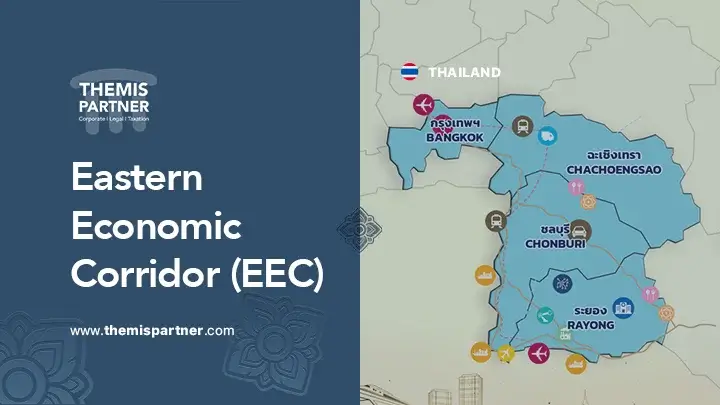Thailand Eastern Economic Corridor (EEC) now generates nearly 15 percent of the country’s GDP, yet it covers just 13 percent of Thailand’s land area.
What makes the EEC so magnetic for investors and professionals? This designated zone reshapes regional industry, offering advanced infrastructure, pro-business regulations, and unprecedented access to high-value markets.

If you want transparent entry paths, robust incentives, and strategic connections, the EEC’s current expansion creates immediate opportunities you can act on, today.
Key Takeaways
- Thailand Eastern Economic Corridor (EEC) delivers robust growth by generating nearly 15% of Thailand’s GDP and drawing over THB 1.92 trillion (USD 56 billion) in foreign direct investment in just five years.
- Investors benefit from streamlined incentives, including multi-year tax holidays, regulatory sandboxes, expedited visas, and flexible foreign ownership rules in designated Special Economic Zones.
- Major infrastructure projects, such as Laem Chabang Deep Seaport expansion and a new high-speed rail network, boost export capacity and connect industrial hubs for efficient regional logistics.
- Targeted “S-Curve” industries receive priority support, positioning high-value sectors like biotech, robotics, digital platforms, and next-gen automotive for accelerated growth and advanced policy incentives.
- Smart city initiatives in Chonburi and Rayong are transforming urban spaces with digitalized public services, green infrastructure, and future-ready amenities that attract both talent and business investment.
- Practical workforce upskilling is central to EEC’s strategy, leveraging dedicated R&D centers, STEM education programs, and public-private partnerships to supply 100,000+ skilled professionals annually.
- Transparent governance and integrated support services empower business owners and professionals to navigate regulations, fast-track approvals, and access world-class infrastructure for strategic expansion.
- Environmental sustainability and inclusive growth remain key priorities, with the EEC enforcing ESG standards, green port certifications, and sustainable urban planning to balance development and community welfare.
Table of Contents
What Is the Thailand Eastern Economic Corridor (EEC)?
EEC Infrastructure Driving Thailand’s Economy
Key Industries Powering EEC Growth
Investment Opportunities in the EEC
Economic and Social Impact of the EEC
FAQ: Thailand Eastern Economic Corridor (EEC)
Conclusion
What Is the Thailand Eastern Economic Corridor (EEC)?
The Thailand Eastern Economic Corridor (EEC) is a designated zone driving Thailand’s most ambitious economic development. Spanning the provinces of Chachoengsao, Chonburi, and Rayong, it anchors strategic growth in advanced industries, logistics, and infrastructure.
Key objectives of the EEC include:
- Fueling Thailand’s “Thailand 4.0” vision for a technology-led, high-income economy
- Aligning with the National 20-Year Strategy to promote sustainable, innovation-driven growth
- Attracting investment through streamlined policies and long-term government commitment
The EEC Act (2018) established robust legal and regulatory support, allowing flexible business operations and offering broad incentives to both local and international investors.
EEC Snapshot: Why It Matters
The EEC covers only 13 percent of Thailand’s land mass but generates around 15 percent of annual GDP.
- Over THB 1.92 trillion (USD 56 billion) in FDI was attracted within the first five years
- Hosts more than 40 industrial estates and is expected to create 200,000 jobs by 2032
- Aims for THB 2.2 trillion (USD 65 billion) in fresh investment by 2028
Key Regions and Cities in the EEC
The EEC’s core lies in Chachoengsao, Chonburi, and Rayong, stretching along the eastern seaboard close to major ports and the Gulf of Thailand.
Key industrial and investment hubs include:
- Chonburi: Laem Chabang Deep Seaport, Bang Lamung, and pioneering smart city districts
- Rayong: Map Ta Phut Industrial Port, leading petrochemical parks, and tech innovation centers
- Chachoengsao: Gateway to new logistics corridors and future-ready manufacturing zones
Visual government resources and interactive maps can be found on the EEC Official Website and Thailand Board of Investment.
For businesses and investors, the EEC stands out as a model of regulatory clarity, infrastructure integration, and strategic opportunity, positioning Thailand as Southeast Asia’s industrial powerhouse.
EEC Infrastructure Driving Thailand’s Economy
Ongoing EEC infrastructure projects are rapidly reshaping Thailand’s economic landscape by boosting logistics options, accelerating industrial efficiency, and enhancing urban livability.
Current projects directly support Thailand’s vision for a modern, export-driven economy while attracting both domestic and foreign investment.
Major Transport and Port Projects
Key EEC projects with the largest economic impact include:
- Laem Chabang Deep Seaport (Phase 3): Expanding export capacity and handling over 18 million TEUs by 2029.
- Map Ta Phut Industrial Port Expansion: Adding new terminals for gas and liquid cargo, fueling industrial demand.
- High-Speed Rail Network: Linking Don Mueang, Suvarnabhumi, and U-Tapao airports, reducing intercity travel to under an hour and supporting 350,000 daily commuters.
- U-Tapao Airport Development: Expected to triple passenger capacity and become a regional aviation hub.
- Water Infrastructure: “East Water Blue Bond” secures reliable water for 400,000 residents and businesses.
Smart Cities and Urban Development
Smart city initiatives in Chonburi and Rayong are driving digital infrastructure, green building, and future-ready urban development:
- Digitalized public transport and utility networks
- Smart traffic, safety, and healthcare solutions
- Sustainable housing and green urban planning
Visualize business parks, automated public services, and eco-smart communities designed around workforce needs.
Advanced infrastructure in the EEC represents a comprehensive commitment to regional progress, ensuring immediate and long-term growth opportunities for investors, professionals, and communities alike.
Key Industries Powering EEC Growth
The Thailand Eastern Economic Corridor (EEC) targets future-focused “S-Curve” industries to drive economic transformation, in line with the Thailand 4.0 vision. These sectors are prioritized for advanced investment incentives and rapid policy support.
Key targeted industries in the EEC include:
- Biotechnology and smart electronics
- Robotics and automation systems
- Aerospace and aviation services
- Digital platforms, including fintech and cloud computing
These clusters are designed to attract high-value manufacturing and technology enterprises seeking regional expansion.
High-Tech and Strategic Sectors
Beyond technology, the EEC’s growth rests on diversified clusters:
- Healthcare hubs and medical tourism
- Integrated logistics and smart supply chain networks
- Automotive manufacturing, particularly next-generation vehicles
- Food innovation, emphasizing safety and traceability
Current flagship projects, such as the expansion of advanced manufacturing zones and medical districts, align with global industrial trends.
Innovation and Workforce Upskilling
Talent development sits at the heart of the EEC’s growth strategy.
Practical workforce initiatives focus on:
- Dedicated R&D centers linking universities and industry
- Technical training programs and STEM education
- Public-private partnerships through the proprietary “EEC Talent Acceleration Ecosystem”
This network supports over 100,000 individuals annually, preparing talent for high-demand roles in science and technology fields.
New investment in upskilling programs and academic collaboration means the EEC is an active catalyst for innovation-driven economic outcomes.
Stakeholders can use this knowledge to identify expanding sectors, leverage talent resources, and connect with EEC innovation partners for sustainable, high-impact growth.
Investment Opportunities in the EEC
The Thailand Eastern Economic Corridor (EEC) currently offers a broad spectrum of investment opportunities for both domestic and foreign investors seeking growth in Southeast Asia’s most advanced industrial zone.
Foreign Direct Investment (FDI) is drawn by government-backed incentives, robust infrastructure, and streamlined regulatory processes, positioning the EEC as a significant investment magnet in the region.
Incentives and Support Programs
The EEC provides investors with:
- A one-stop investment platform for seamless approvals and facilitation
- Streamlined operations within Special Economic Zones (SEZs) for enhanced business efficiency
- Regulatory sandboxes that allow for testing innovative projects under relaxed oversight
- Tax incentives including multi-year corporate tax holidays, and reduced income tax rates for skilled professionals
- Non-tax benefits such as foreign land ownership, expedited visas, work permit processing, and flexible regulations
The Thai government reinforces investor confidence through continuous policy updates and swift resolution of regulatory challenges. For comprehensive guidance, review the UNCTAD Thailand Investment Guide.
Sectors and Locations with High Returns
Investment “hotspots” in the EEC include:
- Over 40 established industrial estates across Chachoengsao, Chonburi, and Rayong
- Smart city development zones and digital innovation corridors
- Upgraded logistics and transport hubs near Laem Chabang Deep Seaport and U-Tapao Airport
Recent case studies highlight major foreign investments in robotics, healthcare, and next-generation automotive sectors, with projected returns boosted by new infrastructure and workforce upskilling initiatives.
The EEC’s blend of policy incentives, infrastructure upgrades, and dedicated support services enables investors to enter prime industries, secure long-term value, and leverage Thailand’s strategic ASEAN connectivity.
Economic and Social Impact of the EEC
Thailand Eastern Economic Corridor (EEC) significantly shapes the national economy and modernizes daily life across key provinces.
EEC-driven projects now contribute nearly 15% of Thailand’s GDP, with more than 200,000 jobs projected by 2032.
This economic engine draws over THB 2.2 trillion (USD 65 billion) in targeted investments, driving wide-ranging urban and workplace transformation.
Community Changes and Opportunities
Residents see tangible shifts in their surroundings, with:
- Job creation and upskilled talent pools bridging skills gaps through specialized training
- Modern amenities, including upgraded healthcare, education access, and improved infrastructure
- The rapid emergence of smart city districts and retail, hospitality, and service growth
Studies document rising income levels, stronger educational prospects, and a vibrant migration of skilled labor to EEC provinces.
Risks and Challenges Ahead
Real progress faces critical hurdles such as:
- Infrastructure strain and transport bottlenecks
- Regulatory complexity, including evolving compliance standards and environmental regulations
- The need for transparent stakeholder alignment and sustained community engagement
Balancing urban expansion with environmental safeguards and inclusive access remains a key policy priority.
These changes present immediate opportunities for business adaptation, workforce planning, and community partnerships.
The EEC’s impact is clear: robust economic momentum, rapid urban improvement, and a platform for ongoing innovation, making it essential for professionals and investors to stay updated and engaged.
FAQ: Thailand Eastern Economic Corridor (EEC)
How Can Foreign Companies Invest in the EEC?
Foreign investors can begin by registering with the EEC’s one-stop service platform, which streamlines licensing, permits, and regulatory procedures.
Required steps include:
- Submitting a business proposal and relevant corporate documentation
- Requesting investment privileges via the Thailand Board of Investment (BOI)
- Appointing a local representative or legal consultant for compliance
- Engaging with EEC-appointed advisors for project guidance
What Skills Are Needed to Work in EEC SEZs?
Professionals typically require a bachelor’s degree or higher, relevant technical or management experience, and skills in areas like robotics, biotech, or digital platforms.
Key points include:
- Fast-tracked visa/work permit processes for targeted professions
- High demand in STEM, advanced manufacturing, logistics, and healthcare
- Evidence of skill shortages can prioritize application review
Are There Sustainability Rules in the EEC?
All projects must meet Thai and EEC-specific environmental standards, including ESG (environmental, social, governance) compliance.
Examples of ongoing green initiatives:
- Clean energy investments and green port certifications
- Wastewater recycling programs and sustainable infrastructure
- Adoption of international benchmarks
How Does the EEC Compare to Other Asian Corridors?
The EEC offers:
- Direct port access and seamless logistics across ASEAN
- Long-term tax holidays and relaxed foreign ownership rules
- High-skilled sector clusters including biotech, aerospace, and next-gen automotive
Investors gain access to world-class infrastructure, pro-business regulations, and tailored incentives. The EEC stands out by linking legal transparency and rapid development with a future-ready ecosystem built for global growth.
Conclusion
Positioning your business within the Thailand Eastern Economic Corridor means tapping into one of Asia’s most advanced and dynamic growth ecosystems, where modern infrastructure, skilled talent, and pro-investment policies actively accelerate your expansion.
You can act now by evaluating project opportunities in EEC industrial estates, connecting with industry innovation hubs, or leveraging the one-stop regulatory support for fast-track business entry.
To ensure your decisions are strategic and fully compliant, contact us. Themis Partner combines deep legal expertise with commercial insight to guide you through every step, from business structure to regulatory incentives, so you can invest confidently and sustainably in the EEC.
